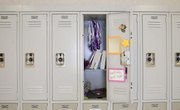Schools are used to working with troubled students and their families to resolve issues both on school grounds and off. However, when a student continually causes disruptions, brings weapons or drugs to school, or commits crimes on school grounds, he may be expelled. States have regulations that cover expelled students, but each state may differ on how expelled students are schooled.
Expulsion
According to the UCLA Law Review, nearly 100,000 students are expelled every year. The National Center for Education Statistics states that nearly three times as many boys are expelled as girls. White students and black students had a nearly equal rate of expulsion, but when the numbers are considered in light of the percentage of the population, black students are expelled at a higher rate. According to the Center for Public Integrity, expulsions themselves have been on the rise in school districts since the 1970s, with a disproportionate number of minority expulsions as compared to the White population.
Student Rights
Students who are expelled have the right to a hearing in every state. Some states, such as Maine and New Jersey have expulsion hearings in front of the local school boards, other states have expulsion hearings by one or two members of a school board, rather than the entire board. Regardless of the state, the United States government requires that an expelled student's parents must be notified of the expulsion and also receive notification of an expulsion hearing. Students have the right to question witnesses at the hearing, and they may testify on their own behalf as well. Students are also allowed to bring a lawyer.
Schooling for Expelled Students
States differ on the education of expelled students. California mandates that all expelled students be educated at an alternative high school for the period of their expulsion. However, some states have no requirements for education of expelled students. Michigan, for example, allows students who have been expelled remain out of school for a year. Louisiana has no alternative school placement for elementary school students. However, middle and high school students can attend alternative school. In the states where alternative schools are mandatory, the schools follow the same curriculum as other high schools. Many alternative schools offer counseling for students and parents and substance abuse therapy in an effort to return students to their regular school.
School Reentry
There are states, such as Louisiana and California, that allow expelled students to return to their home school once they can demonstrate their behavior has improved. In Maine, students may be expelled with an open date for reentry -- upon completion of substance abuse counseling, community service, or therapy-- or they may be expelled with a fixed date for reentry. Texas requires alternative education for expelled students, but usually fixes the date of return at one calendar year. The UCLA Law Review pointed out that in many cases, especially in states with no alternative education programs, students never return to school after an expulsion.
Related Articles
References
- UCLA Law Review: Educating Expelled Students After No Child Left Behind: Mending an Incentive Structure that Discourages Alternative Education and Reinstatement
- Louisiana State Law: Discipline of Students
- Oncle: Texas Education Code
- National Center for Education Statistics: Number of Students Suspended or Expelled by State, Race, and Ethnicity
- The Center for Public Integrity: An Epidemic of Expulsions
Resources
Writer Bio
Lori Garrett-Hatfield has a B.J. in Journalism from the University of Missouri. She has a Ph.D. in Adult Education from the University of Georgia. She has been working in the Education field since 1994, and has taught every grade level in the K-12 system, specializing in English education, and English as a Second Language education.











